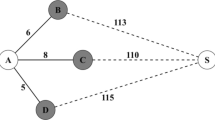Abstract
Internet of Things (IoT) plays an important role in various applications such as industrial control system, environmental monitoring, fire detection, smart home and much more. In today’s scenarios data transmission in emergency rescue is a challenging issue with respect of energy efficient. In this paper, an Energy Efficient Emergency Rescue Scheme (EEERS) is proposed and evaluated which transfers reliable data with high speed and minimum delay in the field of IoT. The simulation is done on MATLAB on different size of network 100–500 sensor nodes. Proposed routing scheme EEERS is compared with existing routing protocols SAR and SPEED on different parameters namely end-to-end delay, throughput, energy consumption, packet loss and packet delivery ratio. Simulation results show that EEERS minimizes end-to-end delay 30–35%, increases throughput 40–42%, reduces energy consumption 50–55%, minimizes packet loss 60–65% and enhances packet delivery ratio 36–40% in emergency rescue environment of IoT. EEERS works on large size of network and prolongs network lifetime.







Similar content being viewed by others
References
Qui T, Lv Y, Xia F et al (2016) ERGID: an efficient routing protocol for emergency response Internet of Things. J Netw Comput Appl 72:104–112
Huang Y, Wang L, Hou Y et al (2018) A prototype IOT based wireless sensor network for traffic information monitoring. IJPRT 11:146–152
Flammini A, Sissini E (2015) Wireless sensor networking in the internet of things and cloud computing era. Eurosensors 87:672–679
Mehta R, Sahni J, Khanna K (2018) Internet of Things: vision, applications and challenges. CCIDS 132:1263–1269
Todli D, Silvestre J, Santonja S et al (2018) Deploy&Forget wireless sensor networks for itinerant applications. Comput Stand Interfaces 56:27–40
Patil HK, Chen TM (2017) Wireless sensor network security: the Internet of Things. CISH 7:317–337
Gaur A, Scotney B, Parr G et al (2016) Smart city architecture and its applications based on IoT. IUPT 52:1089–1094
Shah J, Mishra B (2016) Customized IoT enabled wireless sensing and monitoring platform for smart buildings. ICIAME 23:256–263
Sobral JVV, Rodriguse JJPC, Rabelo RAL et al (2017) A framework for enhancing the performance of internet of things applications based on RFID and WSNs. NCA 22:1–33
Liqiang Z, Shouyi Y, Leibo L et al (2015) A crop monitoring system based on wireless sensor network. Environ Sci 11:558–565
Rani S, Talwar R, Malhotra J et al (2015) A novel scheme for an energy efficient internet of things based on wireless sensor networks. MDPI 21:28603–28627
Mukherjee S, Biswas GP (2017) “Networking for IoT and applications using existing communication technology. Egypt Inform J 12:1–21
Khalil N, Abid MR, Benhaddou D et al (2014) Wireless sensors networks for internet of things. ISSNIP 14378536:1–6
Manrique JA, Rueda JSR, Portocarreo JMT (2016) Contrasting internet of things and wireless sensor network from a conceptual overview. CPSCom 16864829:1–6
Yang T, Xiangyang X, Peng L et al (2018) A secure routing of wireless sensor networks based on trust evaluation model. ICICT 131:1256–1163
Sadek RA (2018) Hybrid energy aware clustered protocol for IoT heterogeneous network. FCIJ 18:1–12
Fernades RF, Brandao D (2016) Proposal of receiver initiated MAC protocol for WSN in urban environment using IoT. IFAC 49:102–107
Sfar AR, Natalizio E, Challal Y et al (2018) A roadmap for security challenges in the Internet of Things. Digit Commun Netw 4:118–137
Ai ZY, Zhou YT, Song F (2018) A smart collaborative routing protocol for reliable data diffusion in IoT scenarios. MDPI 18:1–21
Cecilo J, Martins P, Furtado P (2017) Planning for heterogeneous IoT with time guaranties. ICANT 109:249–256
Devi MD, Geetha K, Saryandevi K (2017) Content based routing using information centric network for IoT. ICACC 115:707–714
Zhong X, Liang Y (2018) Scalable downward routing for wireless sensor networks and internet of things actuation. CSNI 12:1–10
Sung YY, Lee S, Lee M (2018) A multi-hop clustering mechanism for scalable IoT networks. MDPI 22:1–15
Luo M, Luo Y, Wan Y et al (2018) Secure and efficient access control scheme for wireless sensor networks in the cross-domain context of the IoT. Secur Commun Netw 2018:1–11
Soni A, Randhwada R (2018) OSDAP-optimized and secure data aggregation protocol for wireless sensor networks. IJAER 13(5):3027–3033
Singh P, Kaur N, Kaur R (2015) A review: comparative analysis of routing protocols in wireless sensor network. IJNTT 3(1):30–36
Verma N, Singh D (2018) Data redundancy implications in wireless sensor networks. ICCIDS 132:1210–1217
Roy A, Sarma N (2018) Effects of various factors on performance of MAC protocols for underwater wireless sensor networks. ICMS 5:2263–2274
Archana S, Salvan AS (2016) SAR protocol based secure data aggregation in wireless sensor network. In: ISCO, pp 1–6, 2016
Asad M, Niamin Y, Aslam M (2018) Spiral mobility based on optimized clustering for optimal data extraction in WSN. MDPI 18:1–21
Sarkar A, Senthil T (2016) Routing protocols for wireless sensor networks: what the literature says? Alex Eng J 55:3173–3138
Ahmed M, Salleh M, Channa MI (2018) Routing protocols based on protocol operations for underwater wireless sensor network: a survey. Egypt Inform J 19:57–62
Shah SA, Nazir B, Khan IA (2017) Congestion control algorithms in wireless sensor networks: trends and opportunities. JKSU-CIS 29:236–245
Xiaojun L, Xinchun J, Zonguan H (2017) Mobile node aware opportunistic routing in dynamic wireless sensor network. JCUPT 23:15–25
Model and Simulate Dynamic System behavior with MATLAB. https://in.mathworks.com/discovery/modeling-and-simulation.html
Author information
Authors and Affiliations
Corresponding author
Rights and permissions
About this article
Cite this article
Rishiwal, V., Singh, O. Energy efficient emergency rescue scheme in wireless sensor networks. Int. j. inf. tecnol. 13, 1951–1958 (2021). https://doi.org/10.1007/s41870-020-00584-9
Received:
Accepted:
Published:
Issue Date:
DOI: https://doi.org/10.1007/s41870-020-00584-9




